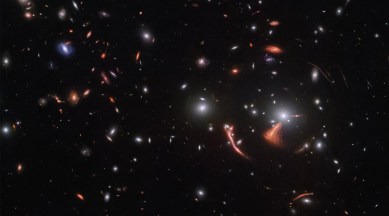Gravity lens allows James Webb Space Telescope to capture distant ‘Cosmic Seahorse’ with ease
The bright arcs and the streaks of light in this Webb image betray a phenomenon known as "gravitational lensing," which scientists use to observe galaxies that otherwise would have been too far away.

A vast gravitational lens is present in this James Webb Space Telescope image released by the European Space Agency. The bright arcs and streaks of light in the image betray its presence.
What is happening here? Essentially, a galaxy cluster in the foreground is bending the light coming from more distant galaxies in the background, warping their shape and creating the bright smears of light that can be spread throughout the image.
This gravitational lensing is sometimes usual because it can magnify distant celestial objects, allowing astronomers to study what would otherwise have been too distant or too faint to observe. In fact, astronomers have used this phenomenon to observe what might be the most distant galaxy observed yet.
The long, bright, distorted arc spreading in one part of the image is an example of gravitational lensing. According to ESA, astronomers have been able to study the Cosmic Seahorse, a distant galaxy, because its brightness was magnified by the gravitational lens. Due to this, astronomers were able to study star formation there.
Webb captures this image with NIRCam, its primary near-infrared camera. The lensing galaxy cluster in the image is labelled SDSS J1226+2149, and it is around 6.3 billion light-years away from our planet in the constellation Coma Berenices.
The researchers used a combination of gravitational lensing and Webb’s sensitivity to explore the earliest stages of star formation in the Cosmic Seahorse galaxy.